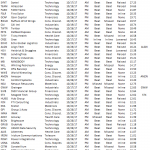Should You Go Short on Sberbank?
Click on picture to enlarge

1 Month Performance of Sberbank of Russia
Sberbank (SBRF) (OTC: SBRCY) has featured prominently in the financial news in September. It dominates the Russian banking scene with approximately 33% control of the banking industry. The Russian banking conglomerate has operations throughout the world and it has come under increasing pressure following Russia’s annexation of Crimea and the punitive sanctions imposed on the country by the international community. With a crumbling ruble, dwindling forex reserves and massive capital flight to contend with Sberbank is feeling the pinch on multiple fronts.
In the second week of September, Sberbank was forced to sell its banking operations in Slovenia after an audit revealed that the market was simply unable to sustain it and offer any growth opportunities. At the time of the sale, 2 buyers were identified: Expobank (a Russian Bank) and US Apollo. The sale bodes poorly for Sberbank’s foray into the Slovenian market, with operations commencing in 2012 when it acquired Volksbank International (an Austrian-owned bank). The Slovenian banking branch of Sberbank had assets valued at €1.94 billion. In total, there are 12 Sberbank branches throughout 8 towns in Slovenia.
The Fitch Downgrade for Sberbank
On the 24 September 2015, Fitch Ratings Inc, one of the 3 largest credit ratings agencies in the U.S., downgraded its outlook on Sberbank subsidiaries. Fitch revised its long-term IDR (Issuer Default Ratings) for Sberbank Europe AG (SBEU) to BB+, its IDR of Sberbank Slovensko (SBSK) to BB+ and its IDR of Sberbank Switzerland (SBS) to BBB-. These major subsidiaries of Sberbank (SBRF) have negatively impacted on the overall financial wellbeing of Sberbank (SBRF). The negative ratings change has resulted in put options being placed on the Russian bank. The Fitch report confirmed the following:













Leave A Comment